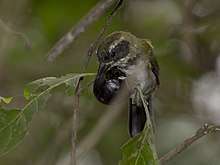Pectoral sparrow
The pectoral sparrow (Arremon taciturnus) is a species of bird in the family Passerellidae. It is found in Bolivia, Brazil, Colombia, French Guiana, Guyana, Peru, Suriname, and Venezuela. Its natural habitat is subtropical or tropical moist lowland forests. The Brazilian name for this species is tico-tico-de-bico-preto, which in translation means "black billed sparrow".[2]
| Pectoral sparrow | |
|---|---|
 | |
| Scientific classification | |
| Kingdom: | Animalia |
| Phylum: | Chordata |
| Class: | Aves |
| Order: | Passeriformes |
| Family: | Passerellidae |
| Genus: | Arremon |
| Species: | A. taciturnus |
| Binomial name | |
| Arremon taciturnus (Hermann, 1783) | |
| Synonyms | |
| |
Taxonomy
The pectoral sparrow was described in 1779 by French polymath Georges-Louis Leclerc, Comte de Buffon in his Histoire Naturelle des Oiseaux under the French name "L'Oiseau Silencieux".[3][4] It was also illustrated in a hand-coloured plate that was produced to accompany Buffon's book.[5] Buffon did not use binomial names but in 1783 the French naturalist Johann Hermann coined the name Tanagra taciturna.[6] The specific epithet taciturnus is the Latin word for "silent" or "quiet".[7] The species is now placed in the genus Arremon that was erected by the French ornithologist Louis Jean Pierre Vieillot in 1816 with the pectoral sparrow as the type species.[8][9]
Three subspecies are recognised:[9]
- A. t. axillaris Sclater, PL, 1854 – northeast Colombia and west Venezuela
- A. t. taciturnus (Hermann, 1783) – east Colombia, central and south Venezuela, the Guianas, Amazonian Brazil and northeast Bolivia
- A. t. nigrirostris Sclater, PL, 1886 – southeast Peru and north Bolivia
Distribution and habitat
The species can be found everywhere in the Amazon Basin except for its western parts. Besides the Amazon jungle it is found in eastern and north-eastern Brazil.[2]
References
- BirdLife International. 2016. Arremon taciturnus. The IUCN Red List of Threatened Species 2016: e.T103771491A94709610. https://dx.doi.org/10.2305/IUCN.UK.2016-3.RLTS.T103771491A94709610.en. Downloaded on 04 February 2018.
- Brazilian name and distribution
- Buffon, Georges-Louis Leclerc de (1780). "L'Oiseau Silencieux". Histoire Naturelle des Oiseaux (in French). Volume 7. Paris: De l'Imprimerie Royale. pp. 429–430.
- Paynter, Raymond A. Jr, ed. (1970). Check-List of Birds of the World. Volume 13. Cambridge, Massachusetts: Museum of Comparative Zoology. p. 182.
- Buffon, Georges-Louis Leclerc de; Martinet, François-Nicolas; Daubenton, Edme-Louis; Daubenton, Louis-Jean-Marie (1765–1783). "Tangara, de la Guiane". Planches Enluminées D'Histoire Naturelle. Volume 8. Paris: De L'Imprimerie Royale. Plate 742.
- Hermann, Johann (1783). Tabula affinitatum animalium olim academico specimine edita, nunc uberiore commentario illustrata cum annotationibus ad historiam naturalem animalium augendam facientibus. Argentorati [Strasbourg]: Impensis Joh. Georgii Treuttel. p. 214, note.
- Jobling, James A. (2010). The Helm Dictionary of Scientific Bird Names. London: Christopher Helm. p. 377. ISBN 978-1-4081-2501-4.
- Vieillot, Louis Jean Pierre (1816). Analyse d'une Nouvelle Ornithologie Elementaire (in French). Paris: Deterville/self. p. 32.
- Gill, Frank; Donsker, David; Rasmussen, Pamela, eds. (2020). "New World Sparrows, Bush Tanagers". IOC World Bird List Version 10.1. International Ornithologists' Union. Retrieved 31 May 2020.
